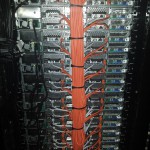Cable management is often an arduous task. While it can take a concerted effort to keep cables organized during installation or upgrades, the time spent on avoiding “cable spaghetti” can have long term benefits on both the user-friendliness of your cabinets, as well as your sanity.
When beginning your buildout, try to keep in mind the wires that connect your hardware to the network are what keep you up and running. Tangled cables can lead to accidental server downtime when your technicians service equipment in a poorly-managed server rack. Even without such a critical issue, longer processing time on service requests due to difficult cable tracing can become a problem. Also, a severe tangle impedes optimal airflow, and can impede heat dissipation and cause hotspots.
Even outside these critical issues of server functionality, the appearance of the cables in your cabinet can leave an important impression on the professionalism of you or your company. The aesthetics of properly managed cables does have a significance in the technical community.

Thankfully, there are many tools that can help you keep your cabinet cables uncrossed, and other techniques to help you know where your wires begin and end.
Tying it Together
There are plenty of fasteners and fastening techniques one can use to manage cables, but using them is the first step. Finding the kind that suits your needs best (as no answer is necessarily perfect in every way) will help you wrangle your hardware’s cables.
Zip ties are an easy to find solution, come in a variety of strengths, lengths, and colors, and are easily removed with a pair of snips. They are also good for keeping cables pulled closely together in tight places. However, they do have to be replaced if removed. Velcro ties are a good reusable item for larger bundles of wires, especially ones that get replaced, removed, or altered often. D-Rings are rigid metal mounted shapes that have an opening to slip individual wires in and out of a bundle without having to unfasten the entire selection of wires.
Color Coding and Cutting to Length
Choosing a selection of colors to represent the various functions in your cabinet can help you find what you’re looking for with much less time and tracing. Granted, this requires a bit of pre-planning and investment in a selection of colored ethernet cable, but the visual cues and associations you gain will not only help jog the memory of you or your technician, it will save you time. In the same vein, custom cables also allow you to specify lengths, taking up less space and material to manage in the first place. While terminating your cables to length does take extra time, the final result will be both astounding and rewarding.
Beyond the simple tools mentioned here, there are even more parts and implements that can further streamline the look and feel of your cabinet. There is plenty of inspiration out there to show you what can be accomplished. Whatever choices to do find appealing, remember that a fantastic looking (and functioning!) server rack just takes some fasteners, and a pair of network cable crimpers, and a little TLC.